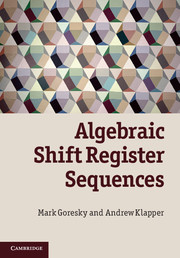Book contents
- Frontmatter
- Contents
- List of figures
- List of tables
- Acknowledgements
- 1 Introduction
- PART I ALGEBRAICALLY DEFINED SEQUENCES
- PART II PSEUDO-RANDOM AND PSEUDO-NOISE SEQUENCES
- 8 Measures of pseudo-randomness
- 9 Shift and add sequences
- 10 m-sequences
- 11 Related sequences and their correlations
- 12 Maximal period function field sequences
- 13 Maximal period FCSR sequences
- 14 Maximal period d-FCSR sequences
- PART III REGISTER SYNTHESIS AND SECURITY MEASURES
- PART IV ALGEBRAIC BACKGROUND
- Bibliography
- Index
11 - Related sequences and their correlations
from PART II - PSEUDO-RANDOM AND PSEUDO-NOISE SEQUENCES
Published online by Cambridge University Press: 05 February 2012
- Frontmatter
- Contents
- List of figures
- List of tables
- Acknowledgements
- 1 Introduction
- PART I ALGEBRAICALLY DEFINED SEQUENCES
- PART II PSEUDO-RANDOM AND PSEUDO-NOISE SEQUENCES
- 8 Measures of pseudo-randomness
- 9 Shift and add sequences
- 10 m-sequences
- 11 Related sequences and their correlations
- 12 Maximal period function field sequences
- 13 Maximal period FCSR sequences
- 14 Maximal period d-FCSR sequences
- PART III REGISTER SYNTHESIS AND SECURITY MEASURES
- PART IV ALGEBRAIC BACKGROUND
- Bibliography
- Index
Summary
In this chapter we briefly review some of the sequences that are related to m-sequences, many of which have found applications in communications. See also Section 15.5, where the linear span of sequences derived from m-sequences is discussed. Further information on these and many other sequences may be found in Helleseth and Kumar's survey article [88], Cusick, Ding, and Renvall's monograph [35], and Golomb and Gong's textbook [63].
Welch bound
For applications to spread spectrum communications, one attempts to find a collection of shift distinct sequences with low pairwise cross-correlation values. For a given (maximal) cross-correlation, there are theoretical limitations on the number of sequences in such a collection, the simplest of which is the Welch bound [204].
Suppose we have a collection of n periodic sequences of elements in a finite field F, each with the same period T. We can expand this set to include all the shifts of these sequences. If T is the minimal period of each sequence and the sequences are pairwise shift distinct, then we obtain a set of N = Tn vectors, commonly referred to as a signal set. Let us denote these vectors by a(1), a(2), …, a(N). Let χ : F → ℂ× be a nontrivial character.
- Type
- Chapter
- Information
- Algebraic Shift Register Sequences , pp. 230 - 249Publisher: Cambridge University PressPrint publication year: 2012



